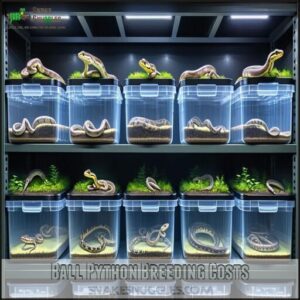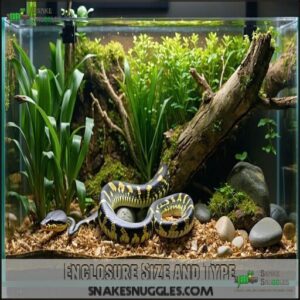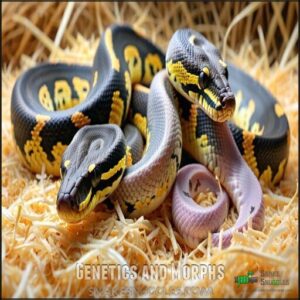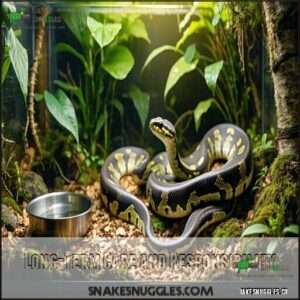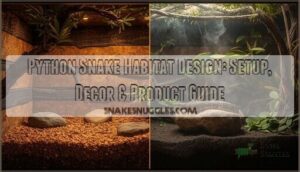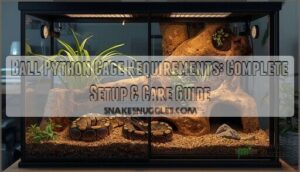This site is supported by our readers. We may earn a commission, at no cost to you, if you purchase through links.
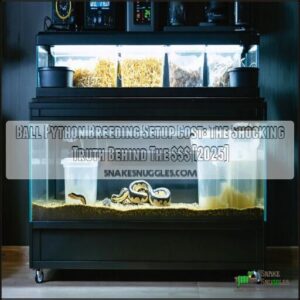
A quality enclosure, like a 67-gallon terrarium, runs about $200, while heating elements, lighting, and thermostats add another $150 or so.
Substrate options like coconut bedding or aspen snake shavings range from $10 to $30 per bag.
Don’t forget essentials like hides, water bowls, and humidity control tools, which can tack on another $50.
If you’re splurging on high-end gear or rare morphs, costs climb quickly, but breeding responsibly isn’t cheap, but it’s worth every penny when you see those hatchlings thrive!
Table Of Contents
- Key Takeaways
- Ball Python Breeding Costs
- Top 7 Breeding Setup Essentials
- Ball Python Habitat Requirements
- Breeding Ball Pythons Successfully
- Monthly Ball Python Ownership Costs
- Frequently Asked Questions (FAQs)
- How much do ball python Breeders cost?
- How much does it cost to adopt a ball python?
- How much does a ball python habitat cost?
- Is it possible to breed ball pythons?
- How much does a ball python enclosure cost?
- How much does a albino ball python cost?
- What are the best tools for egg incubation?
- How do you identify breeding readiness in ball pythons?
- What are common mistakes in breeding setups?
- How can you safely transport breeding pairs?
- Conclusion
Key Takeaways
- Plan to spend $250–$800 for a proper ball python setup, covering enclosures, heating, substrate, and essential accessories like hides and humidity tools.
- Budget $1,000–$5,000 for breeding costs, factoring in enclosures, breeding stock, and an incubator for healthy offspring.
- Choose high-quality equipment like thermostats, heat mats, and proper substrate to avoid common issues like poor humidity and shedding problems.
- Prioritize ethics and genetics when sourcing breeding pairs to ensure healthy snakes and reduce potential health risks.
Ball Python Breeding Costs
You’ll need to invest $1,000-$5,000 to start breeding ball pythons, with costs covering enclosures, heating equipment, substrate, breeding stock, and an incubator.
Starting ball python breeding costs $1,000-$5,000, covering essentials like enclosures, heating, substrate, breeding stock, and an incubator.
Your wallet might feel the squeeze initially, but establishing a proper setup from the beginning helps guarantee healthier offspring and reduces expensive problems down the road, which is crucial for a successful breeding process with ball pythons.
Initial Setup Costs
Starting your ball python breeding journey’s initial costs will make your wallet sweat, but knowing what to expect helps with planning.
You’re looking at a significant investment for proper setup, including:
- Basic breeding setups range from $500-$2,500, depending on snake quantity and morphs
- Adult enclosures cost $500-$700, forming the bulk of your initial investment
- DIY options like $100 incubators can save money while maintaining quality
The initial investment is crucial for a successful breeding journey, and understanding these costs can help with planning.
Ongoing Expenses
While setting up your ball python breeding operation requires substantial upfront investment, the ongoing expenses will drain your wallet month after month.
| Expense Category | Monthly Cost | Annual Impact |
|---|---|---|
| Food Expenses | $9-15 | $100-180 |
| Veterinary Care | $0-50+ | Variable |
| Environment Maintenance | $20-50 | $240-600 |
Don’t underestimate electricity and utility bills for heating costs, substrate replacement, and enrichment items. Consider that proper humidity control is also essential for their health. That cute python’s ongoing maintenance might’ve you eating ramen more often than you’d like, due to the substantial upfront investment and ongoing expenses that come with ball python breeding.
Factors Affecting Costs
While managing ongoing costs keeps your wallet happy, several factors will dramatically influence your initial breeding setup cost.
Your shopping list’s bottom line depends on various factors, including morph rarity, with standard morphs at $50-100 vs. designer morphs at $450+, and breeder reputation, with established breeders charging $75-500.
The source location also plays a role, with pet stores vs. online marketplaces having $50+ shipping, and adoption fees ranging from $25-100 for budget-friendly options.
Additionally, python age is a factor, as younger snakes cost less but need time to mature, with considerations including:
- Morph rarity
- Breeder reputation
- Source location
- Adoption fees
- Python age
Top 7 Breeding Setup Essentials
You’ll need these seven essential items for a successful ball python breeding setup, saving yourself the headache of emergency shopping runs when your snakes decide it’s romance time.
From the spacious REPTI ZOO 67 Gallon Terrarium to the perfect substrate mix of ReptiChip and Zoo Med Aspen bedding, these carefully selected products guarantee your breeding ball pythons will thrive without breaking your wallet.
1. ReptiSun 5.0 UVB Reptile Bulb
View On Amazon
A vital investment for your breeding setup, the ReptiSun 5.0 UVB bulb provides essential 5% UVB output that helps your ball pythons naturally regulate their Vitamin D3 levels without risking overdose from supplements.
Available in three sizes (12", 22", and 34") at $12.99-$16.99, this bulb also emits 30% UVA to stimulate appetite, activity, and breeding behaviors.
You’ll need to replace it every 6-12 months and pair it with a proper basking light.
Remember, while not mandatory for ball pythons, proper UVB exposure supports overall psychological well-being and natural behaviors.
Best For: Reptile enthusiasts looking to enhance the health, activity, and breeding behaviors of tropical and desert reptiles.
- Provides 5% UVB and 30% UVA for vitamin D3 synthesis and natural behaviors.
- Affordable pricing with sizes compatible for various enclosures.
- Supports appetite, activity, and psychological well-being in reptiles.
- Requires replacement every 6-12 months for effectiveness.
- Needs pairing with a basking light for optimal results.
- Not mandatory for ball pythons, limiting specific use cases.
2. Exo Terra Repti Glo Terrarium Lamp
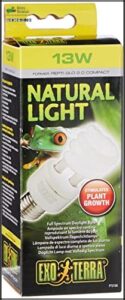
The Exo Terra Repti Glo Terrarium Lamp comes in three versions (2.0, 5.0, and 10.0), each with different UVB outputs to match your breeding setup needs.
You’ll appreciate how it enhances your ball pythons’ natural colors while adding minimal heat to the enclosure.
The sturdy construction features a metal reflector and heat-resistant ceramic socket that handles bulbs up to 200W.
While it’s not a primary heat source, its full-spectrum light creates that "slice of daylight" look that makes your breeding facility look professional.
Don’t forget to pair it with a proper heating element!
Best For: Breeders and reptile enthusiasts looking for a full-spectrum light that enhances natural colors and supports reptile health with minimal heat.
- Does not function as a primary heat source, requiring additional heating elements.
- Limited to specific UVB outputs, which may not suit all species or setups.
- Some users report defective products if unboxed late.
- Offers full-spectrum daylight-like lighting for improved aesthetic and reptile health.
- Durable construction with a metal reflector and heat-resistant ceramic socket.
- Suitable for bulbs up to 200W, providing versatility in terrarium setups.
3. ReptiChip Coconut Reptile Substrate Bedding
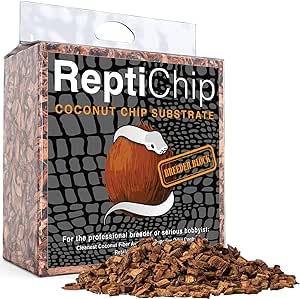
Creating a tropical oasis for your ball python becomes effortless with ReptiChip Coconut Reptile Substrate.
This 72-quart compressed brick expands to 10 pounds of premium bedding when hydrated, giving you excellent value.
You’ll appreciate how it maintains ideal humidity levels—crucial for successful breeding environments.
The 100% organic coco chips are fastidiously cleaned, making them dust-free and perfect for sensitive reptiles.
Ball python breeders love how it encapsulates waste and absorbs odors, keeping maintenance simple.
For about $20-30 per brick, it’s a smart investment in your breeding setup’s foundation.
Best For: Reptile owners and breeders seeking a high-quality, humidity-retaining, odor-absorbing substrate for species like ball pythons, geckos, turtles, and frogs.
- Excellent humidity retention for breeding or tropical setups.
- 100% organic, sustainable, and dust-free coconut husk material.
- Odor-absorbing and easy to clean for low-maintenance care.
- Requires hydration before use, adding an extra preparation step.
- Can be more expensive per brick compared to other bedding options.
- Not suitable for arid habitat species requiring low humidity.
4. Zoo Med Aspen Snake Bedding
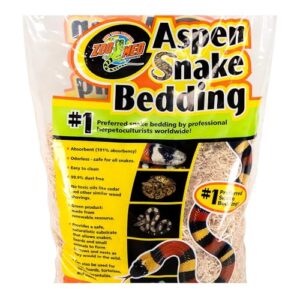
Why is Zoo Med Aspen Snake Bedding the #1 choice among professional herpetoculturists? It’s simple—this 99.9% dust-free, hypoallergenic substrate offers superior absorption with no harmful oils.
At $6 per bag, you’re getting excellent value for a product that lasts 30-60 days between changes. Your ball pythons will love burrowing through the perfect-sized chunks, and you’ll appreciate the minimal dust and light natural scent.
It maintains humidity well but needs monitoring to prevent mold. For breeding setups, this USA-made bedding creates a clean, healthy environment your snakes will thrive in.
Best For: Snake owners, especially those with burrowing species like hognose or ball pythons, seeking a clean, safe, and easy-to-maintain bedding solution.
- 99.9% dust-free, hypoallergenic, and non-toxic.
- Superior absorption with no harmful oils, maintaining a healthy environment.
- Encourages natural burrowing and nesting behaviors in snakes.
- Requires monitoring to avoid mold in high-moisture setups.
- Slightly dusty when first poured but settles quickly.
- Compressed packaging needs loosening before use.
5. Galápagos Terrarium Green Sphagnum Moss
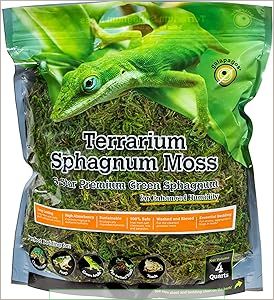
You’ll definitely want to pick up Galápagos Terrarium Green Sphagnum Moss for your ball python breeding setup.
This long-lasting, leafy substrate helps maintain ideal humidity levels vital for successful breeding and proper shedding.
Coming in 4-quart resealable bags priced between $12.99-$16.50, it’s a cost-effective addition to your breeding essentials.
The moss has been thoroughly washed to remove dust particles, making it safe for your precious snakes.
It’s particularly valuable in breeding setups where maintaining tropical conditions can make the difference between successful and failed breeding attempts, and its ability to help with proper shedding is also noteworthy.
Best For: Reptile and amphibian enthusiasts looking to maintain optimal humidity and support shedding in tropical or wetland terrariums.
- Maintains ideal humidity for tropical environments.
- Safe, clean, and thoroughly washed to remove dust.
- Affordable and long-lasting substrate for terrarium setups.
- Limited to a 4-quart bag size.
- Not ideal for dry or arid species.
- Price range may vary slightly depending on retailer.
6. Fluker’s Pothos Repta Vines for Terrariums
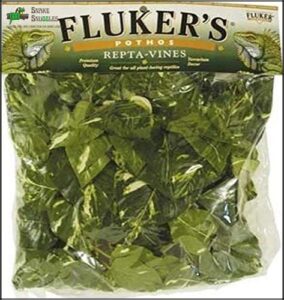
Your ball python’s habitat needs a touch of natural aesthetics, which is where Fluker’s Pothos Repta Vines come in handy.
These 6-foot lifelike vines add a natural look to any terrarium while providing climbing opportunities for your snake.
Made from non-toxic polyethylene, they’re safe and easy to clean—just wipe them down during regular maintenance.
The included suction cups make installation a breeze, and you can bend or twist them to fit any enclosure size.
At about $15-20, they’re an affordable way to enhance your breeding setup’s environment, providing a great value with easy maintenance and natural look.
Best For: Reptile owners looking for an affordable, natural-looking, and easy-to-maintain decoration for their terrarium.
- Non-toxic and safe for reptiles.
- Easy to clean and maintain.
- Flexible and versatile for various enclosure sizes.
- Suction cups may lose grip over time.
- Limited to a 6-foot length per vine.
- May require multiple vines for larger enclosures.
7. REPTI ZOO 67 Gallon Terrarium
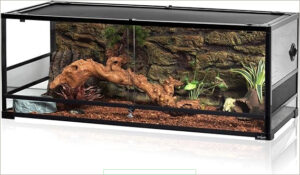
Upgrade your breeding setup with the REPTI ZOO 67 Gallon Terrarium, a spacious home that’s worth every penny.
With dimensions of 24"x18"x36", this enclosure features thick tempered glass for durability and safety.
You’ll appreciate the double-hinged doors that open separately for easy feeding and cleaning, plus the secure lock to prevent escape artists from breaking free.
It’s versatile enough for both desert and rainforest setups, with proper ventilation and UVB penetration through the mesh top.
Proper airflow is essential to prevent respiratory problems in reptiles.
Assembly takes just five minutes – a real time-saver!
Best For: Reptile enthusiasts looking for a durable, easy-to-assemble terrarium suitable for both desert and rainforest setups.
- Durable thick tempered glass ensures safety and longevity.
- Easy five-minute assembly saves time during setup.
- Excellent ventilation allows UVB and infrared light for reptile health.
- Relatively expensive compared to other terrarium options.
- No included accessories like heat lamps or substrate.
- Glass panels are not covered under free replacement policy.
Ball Python Habitat Requirements
You’ll need to create a proper home for your ball python that meets all their needs, including the right enclosure size, heating elements, and humidity controls that won’t break the bank.
Creating this reptilian paradise might make your wallet a bit lighter initially, but your scaly friend will reward you with years of healthy breeding potential and fewer vet bills down the road, resulting in a more reptilian paradise.
Enclosure Size and Type
Regarding enclosure size requirements, your ball python’s habitat should grow with them.
For juveniles under 3 feet, a 40-gallon tank (36"×18"×18") works well, but adults need at least 75 gallons (48"×24"×24").
While some breeders use 17"×33"×5" tubs for pairs, single housing in enclosures offering 3-6 square feet of space is ideal.
Custom builds or secondhand enclosures can reduce costs while still meeting your snake’s enrichment needs, and providing a suitable environment is crucial for their well-being, considering factors such as enclosure size.
Heating and Lighting Setups
Creating the right heating and lighting setup keeps your ball python healthy.
Use a heat mat with thermostat control for safe, consistent warmth, and set a basking spot temp between 88-92°F.
For a reliable setup, consider ball python heating products.
Heating options like UVB lights enhance lighting schedules but aren’t mandatory.
Avoid unsafe heating elements like heat rocks; they’re more trouble than they’re worth!
Substrate and Humidity Control
After heating setups, let’s tackle substrate and humidity control.
The right ball python substrate, like aspen or sphagnum moss, helps maintain proper humidity levels, preventing shedding issues.
Avoid mold by spot-cleaning and choosing breathable substrate types.
Consider various substrate options for your ball python.
Substrate and decor choices also affect cost analysis—expect $15-$40 upfront, with ongoing replacements.
Remember, healthy humidity means a happy snake!
Breeding Ball Pythons Successfully
Breeding ball pythons successfully isn’t just about pairing snakes; it’s about understanding genetics, ethics, and long-term care.
Breeding ball pythons thrives on patience, ethical practices, and mastering genetics for healthy, stunning offspring.
If you’re ready to take on the challenge, you’ll need patience, proper planning, and a setup that keeps both your snakes and wallet happy.
Genetics and Morphs
Ball python genetics play a big role in breeding success, especially in developing new morphs.
Understanding genetic inheritance, from dominant traits to recessive genes, helps you predict outcomes and avoid surprises.
Morph identification is key—certain ball python morphs impact costs substantially.
Rare patterns, like Pieds, command higher prices, while standard ones are more affordable.
Genetics and morphs impact everything—breeding, budget, and beyond!
Breeding Ethics and Sourcing
Breeding ethics and sourcing matter more than Morph Demand.
Without responsible sourcing, genetic mutations skyrocket, harming snakes’ health.
Ethical breeding practices prioritize Genetic Diversity and animal welfare over profits.
Researching reputable breeders guarantees Breeder Reputation aligns with ethical standards.
Avoiding shortcuts or questionable practices respects the species’ well-being.
It’s about loving them, not just their looks!
Long-Term Care and Responsibility
How do you manage long-term care without breaking the bank? Stick to high-quality husbandry standards and plan for ongoing care costs.
Budget for food expenses, environment maintenance costs, and occasional veterinary care costs. Keep enrichment strategies simple yet effective—snakes love exploring hides!
Ethical considerations and financial planning guarantee your ball python thrives, despite economic factors. To further guarantee their well-being, prioritize snake stress reduction.
Monthly Ball Python Ownership Costs
Owning a ball python isn’t just a one-time expense—it’s a monthly commitment that can sneak up on you if you’re not prepared.
From feeding costs to maintaining their cozy setup, you’ll want to budget carefully to keep your scaly friend happy and healthy.
Food and Feeding Expenses
Feeding your ball python isn’t rocket science, but it does require planning.
Prey size matters—too small, they’re hungry; too big, they’re stressed.
Feeding frequency varies by age; hatchlings eat weekly, adults every 2-4 weeks.
Frozen vs. live? Frozen saves money and reduces waste.
Ball python food costs $50-$80 monthly, depending on dietary needs.
Nutritional supplements? Rarely necessary!
Veterinary Care and Medications
Keeping your ball python healthy means planning for veterinary care costs.
Annual check-ups, emergency treatment, and medications can add up quickly.
Here’s what to expect:
- Preventative Care: $50–$100 per visit.
- Emergency Treatment: Costs vary but can spike unexpectedly.
- Medication Costs: Parasite treatments or chronic issues.
- Insurance Options: Pet insurance offsets surprises but adds monthly expenses.
Consider purchasing specialized reptile products for ideal health.
Healthy snakes save money!
Environment Maintenance and Upgrades
Maintaining your ball python’s environment isn’t rocket science, but it does take planning.
Substrate options, humidity control, and heating upgrades are key. Automation systems can save time, though they’ll bump up ball python electricity costs.
Regular enclosure cleaning keeps things fresh and healthy. Proper care guarantees a ball python’s longevity.
Check out the breakdown below:
| Task | Frequency | Cost Range |
|---|---|---|
| Substrate Change | Monthly | $10–$30 |
| Heating Upgrades | Occasionally | $20–$50 |
| Enclosure Cleaning | Weekly/Biweekly | Minimal (DIY) |
Emergency Funds and Pet Insurance
When snake emergencies strike, emergency savings or reptile pet insurance options can save the day.
Unexpected illness or injury costs add up fast, so plan ahead. Compare policies for the best insurance coverage or set aside funds for veterinary costs.
- Start an emergency fund early.
- Check exotic pet insurance plans.
- Budget for emergency medical expenses.
- Build a vet relationship for flexibility to ensure you have options when emergency situations arise.
Frequently Asked Questions (FAQs)
How much do ball python Breeders cost?
Breeders can cost anywhere from $75 to over $500, depending on the ball python’s morph.
While rare morphs climb higher, standard ones stay budget-friendly.
Reputable breeders guarantee healthier snakes, so it’s worth the investment!
How much does it cost to adopt a ball python?
Adopting a ball python usually costs $25 to $100, making it a budget-friendly option.
It’s a great way to save money while giving a snake a second chance at a loving home.
How much does a ball python habitat cost?
Setting up a ball python habitat costs $250–$800, depending on your choices.
Essentials include an enclosure, heating elements, substrate, hides, and gauges.
A 40-gallon tank or larger is ideal—think cozy yet functional!
Is it possible to breed ball pythons?
Absolutely, you can breed ball pythons!
It takes proper planning, a healthy breeding pair, and the right setup, like enclosures, heating, and an incubator.
Patience is key—success won’t happen overnight, but it’s rewarding!
How much does a ball python enclosure cost?
A ball python enclosure costs $50 to $300, depending on size and type. A 40-gallon tank is ideal for adults, running $75 to $ Choosing durable materials saves you money long-term.
How much does a albino ball python cost?
An albino ball python’s cost can vary wildly, like a rollercoaster ride, starting around $300 and climbing past $1,000, depending on its genetics, breeder reputation, and age.
Shop smart, and compare options!
What are the best tools for egg incubation?
You’ll need a reliable incubator (DIY or store-bought), a thermostat to maintain temperature, and hygrometers for humidity.
Use vermiculite or perlite as a substrate, and make sure everything’s clean—no one likes moldy eggs!
How do you identify breeding readiness in ball pythons?
Check for consistent feeding, healthy weight, and proper age—usually 2-3 years old.
Males need 700+ grams; females, 1,200+ grams.
Watch for courting behavior, like tail wagging or restless crawling, to confirm readiness.
What are common mistakes in breeding setups?
Skipping thermostats, overcrowding enclosures, or skimping on humidity control are big mistakes.
Improper heat gradients stress snakes, overcrowding spreads illness, and low humidity leads to shedding issues.
Focus on your setup details; it’s worth it!
How can you safely transport breeding pairs?
Use secure, ventilated containers with locking lids, lined with soft material to prevent injury.
Label each container, maintain consistent temperature and humidity during transit, and avoid overcrowding pairs to reduce stress and potential injuries, ensuring secure and ventilated conditions.
Conclusion
Breeding ball pythons might seem like a wallet-emptying adventure, but it doesn’t have to be overwhelming if you plan wisely.
The ball python breeding setup cost, from enclosures to substrate and heating, is an upfront investment that pays off when your setup thrives.
Remember, cutting corners on essentials can lead to bigger headaches later, but with the right gear, a little research, and responsible practices, you’ll create a habitat where your pythons—and future hatchlings—flourish effortlessly!

